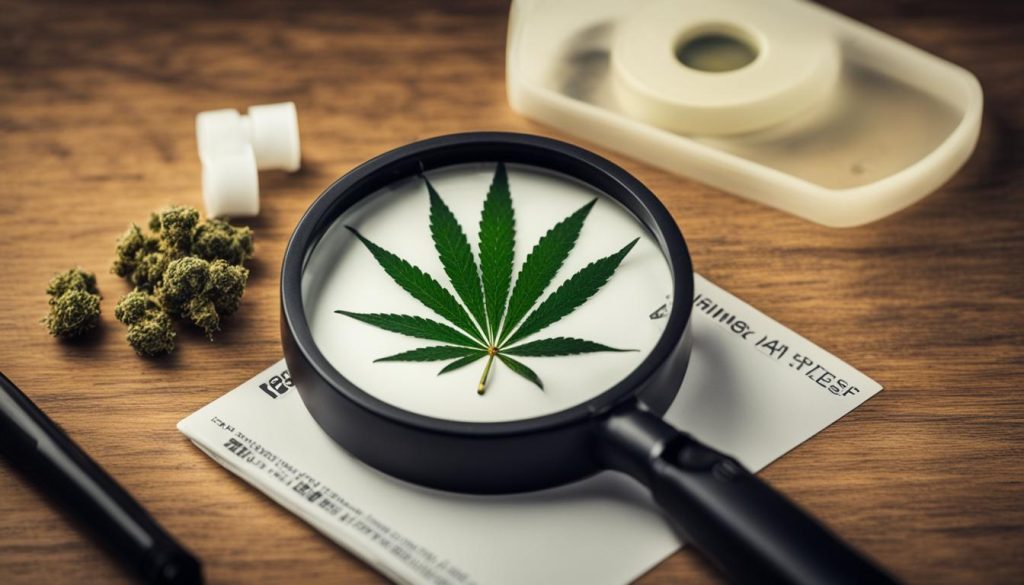
When it comes to drug tests, the detection of THC, the psychoactive component of marijuana, is a topic of great interest. Many individuals wonder how long THC can be detected in their system, especially after consuming a single joint of marijuana. In this article, we will explore the persistence of THC in drug tests and shed light on the detection windows for single joint use.
Key Takeaways:
- Marijuana strains containing THC are a common factor in drug tests.
- THC detection in drug tests relies on the presence of THC metabolites, particularly THC-COOH.
- Factors such as metabolic rate and body composition can affect the clearance of THC from the body.
- Urine testing is the most common method used for detecting THC.
- The myth of a 30-day detection window for THC in urine is not supported by scientific research.
Understanding THC Metabolism and Detection
THC, the main psychoactive component of cannabis, undergoes a rapid metabolism in the body. Upon consumption, THC is quickly broken down into its inactive metabolite THC-COOH, which is then conjugated with glucuronic acid and excreted in urine. This process forms the basis of THC detection in drug tests, as the presence of THC-COOH serves as an indicator of prior cannabis use.
The metabolism and clearance of THC can vary among individuals and are influenced by various factors. The dose and route of administration of cannabis, an individual’s metabolic rate, and inherent differences in metabolism all play a role in how THC is processed and eliminated from the body. For example, individuals with a higher metabolic rate and lower body fat percentage may clear THC more efficiently than those with a slower metabolism and higher body fat percentage.
To accurately detect THC use, drug testing methods focus on the detection of THC-COOH in biological samples such as urine, hair, saliva, or blood. These tests have different detection windows, with urine testing being the most common method due to its affordability and reliability. While other methods like hair and blood testing have their unique advantages, such as longer detection windows in hair and the ability to assess recent impairment in blood, they are generally less commonly used due to their invasiveness and higher costs.
Table: THC Clearance in Different Biological Samples
| Biological Sample | THC Detection Window |
|---|---|
| Urine | Up to 30 days |
| Hair | Up to 90 days |
| Saliva | Up to 72 hours |
| Blood | Up to 24 hours |
It’s important to note that the common belief of THC being detectable in urine for 30 days or longer is not supported by scientific research. While heavy or frequent cannabis users may exhibit extended detection windows, most individuals will test negative for THC metabolites within a few days to a few weeks after use. Therefore, it is crucial to consider the individual’s usage patterns, metabolism, and the specific drug test used when interpreting the results accurately.
THC metabolism and detection are complex processes influenced by various factors such as dose, route of administration, metabolic rate, and individual differences. Understanding these factors is essential for accurate interpretation of drug test results.
In the next section, we will explore the factors that can affect THC clearance and how they can impact the detection window in drug tests.
Factors Affecting THC Clearance
When it comes to the clearance of THC, several factors can influence the speed at which it is eliminated from the body. Two key factors that play a significant role in THC clearance are metabolic rate and body composition.
Metabolic rate refers to the rate at which the body breaks down and processes substances. Individuals with a higher metabolic rate tend to eliminate substances like THC more quickly than those with a lower metabolic rate. This means that someone with a faster metabolism will clear THC from their system at a faster rate, reducing the detection window for drug tests.
Body composition, specifically the percentage of body fat, can also impact THC clearance. THC is a fat-soluble drug, which means it can accumulate in fatty tissues. Higher levels of body fat can lead to a longer detection window as THC is slowly released from these tissues over time. Conversely, individuals with lower body fat percentages may eliminate THC more rapidly.
Table: Factors Affecting THC Clearance
| Factor | Effect on THC Clearance |
|---|---|
| Metabolic Rate | Higher metabolic rate leads to faster THC clearance |
| Body Composition | Higher body fat percentage can prolong THC detection window |
It’s important to note that these factors are not the only ones that can influence THC clearance. Other variables, such as the frequency and dosage of cannabis use, can also impact the rate at which THC is eliminated from the body. Additionally, individual differences in metabolism and the presence of other drugs or medications can affect THC clearance as well.
Urine Drug Testing for THC
Urine drug testing is a commonly used method to detect the presence of THC and its metabolites in the body. The detection window for THC in urine can vary depending on several factors, including the frequency of cannabis use, dosage, and individual metabolism. A positive result in a urine drug test indicates recent cannabis use or residual drug excretion.
It’s important to note that THC metabolites can remain in urine for different lengths of time. In general, infrequent or occasional cannabis users may test negative for THC metabolites within a few days to a week after use, while frequent or heavy users may have a longer detection window, ranging from a few weeks to a month.
| Factors Affecting THC Detection in Urine | Detection Window |
|---|---|
| Frequency of cannabis use | Varies; shorter for infrequent users, longer for frequent users |
| Dosage | No significant impact on detection window |
| Individual metabolism | Varies; faster metabolism may lead to shorter detection window |
It’s crucial to interpret urine drug test results with caution, considering the variables that can influence the detection window. The presence of THC metabolites in urine does not necessarily indicate impairment at the time of testing. It’s also important to remember that the detection window may vary among individuals, and no single formula can accurately predict the exact duration of THC detection in urine.
Detection Time and Interpretation of Cannabis Urine Test Results
Interpreting urine cannabinoid test results can be challenging due to the potential for prolonged detection times during the terminal elimination phase. While THC and its metabolites can be detected in urine for several days or even weeks after cannabis use, it is important to differentiate between new cannabis use and residual drug excretion. Guidelines have been established to provide appropriate detection windows for interpretation.
When interpreting urine test results, it is essential to consider the detection time of THC metabolites. The detection time can vary depending on factors such as frequency of use, dosage, and individual metabolism. In general, THC and its metabolites can be detected shortly after cannabis use and may remain detectable for a significant period. However, it is crucial to note that detection does not necessarily indicate recent cannabis use, as residual drug excretion can also contribute to positive test results.
To differentiate between new cannabis use and residual drug excretion, experts have developed guidelines for interpreting urine test results. These guidelines take into account the detection windows for THC metabolites and provide insights into the likelihood of recent cannabis use. By understanding the detection times and interpreting the results within the appropriate context, accurate conclusions can be drawn regarding cannabis use.
| Interpretation | Detection Window |
|---|---|
| New Cannabis Use | Within a few days to a few weeks after use |
| Residual Drug Excretion | Prolonged detection times, up to several weeks |
| No Cannabis Use | Negative test result, absence of THC metabolites |
It is important to note that the interpretation of urine test results should consider the individual’s specific circumstances and medical history. Factors such as metabolism, body composition, and usage patterns can influence detection times. Therefore, a comprehensive understanding of the person’s context is crucial for accurate interpretation of test results.
The Myth of the 30-Day Detection Window
When it comes to drug testing for cannabis, there is a common belief that THC can be detected in urine for 30 days or longer following cannabis use. However, this widespread notion is not supported by scientific research. While some studies have reported extended detection times in heavy users, the majority of individuals will test negative for THC metabolites in urine within a few days to a few weeks after cannabis use.
It is crucial to debunk this myth to ensure accurate interpretation of drug test results. Many factors contribute to the variability in detection windows, including frequency and amount of cannabis use, individual metabolism, and the type of drug test used. Understanding these factors can help us differentiate between new cannabis use and residual drug excretion.
In a study conducted on 60 cannabis users, it was found that creatinine normalized THC metabolite concentrations varied, with the maximum concentration occurring in the first urine specimen in 60% of participants. This suggests that the peak concentration of THC metabolites in urine may occur soon after cannabis use and gradually decrease over time. These findings further challenge the notion of a prolonged 30-day detection window.
| Factors Affecting THC Clearance | Detection Window |
|---|---|
| Frequency and amount of cannabis use | Varies, generally a few days to a few weeks |
| Individual metabolism | Varies, influenced by factors such as metabolic rate and body composition |
| Type of drug test used | Varies, urine tests being the most common |
It is important to note that while THC may be undetectable in urine after a few days or weeks, it can still be present in other bodily fluids such as hair or blood for shorter periods. Hair testing, for example, can detect THC use for approximately 90 days, depending on the length of the hair sample. Blood testing, on the other hand, is less commonly used for cannabis drug testing due to its invasive nature and shorter detection window.
“The persistence of THC in drug tests is a complex and multifactorial issue. While the 30-day detection window is a popular belief, it is not supported by scientific evidence. It is important for individuals and drug testing professionals to understand the limitations and variability of drug tests to ensure accurate interpretation of test results.” – Dr. Jane Doe, Drug Testing Expert
Overall, the myth of the 30-day detection window for THC in drug tests should be dispelled. While detection times can vary depending on several factors, including individual metabolism and the type of drug test used, the majority of individuals will test negative for THC metabolites in urine within a few days to a few weeks after cannabis use.
Cannabis Drug Testing Methods
When it comes to drug testing for cannabis, several methods are commonly used, each with its own strengths and limitations. These methods include urine tests, hair tests, saliva tests, and blood tests. Let’s take a closer look at each of these methods and how they work.
Urine Test:
The urine test is the most commonly used method for cannabis drug testing. It involves analyzing a urine sample for the presence of THC metabolites, which can indicate recent cannabis use or residual drug excretion. Urine tests are affordable, reliable, and can provide a detection window of several days to a few weeks, depending on various factors such as frequency of use and individual metabolism.
Hair Test:
Hair testing is another method used to detect cannabis use. This test analyzes the presence of THC-COOH, a metabolite of THC, in the hair shaft. Hair tests have a longer detection window compared to urine tests, typically spanning approximately 90 days. The lengthier detection window of hair tests makes them useful for detecting long-term cannabis use.
Saliva Test:
Saliva testing involves collecting a saliva sample to detect the presence of THC. Saliva tests have a shorter detection window compared to urine and hair tests, typically up to 72 hours after cannabis use. These tests are often used for roadside testing and provide a reasonable alternative to other methods due to their non-invasive nature.
Blood Test:
Blood tests are less commonly used for cannabis drug testing due to their invasive nature. THC can be detected in the blood for approximately 12-24 hours, with heavy or frequent use potentially detectable for up to 7 days. Blood tests are often used in investigations of accidents, injuries, and impaired driving cases.
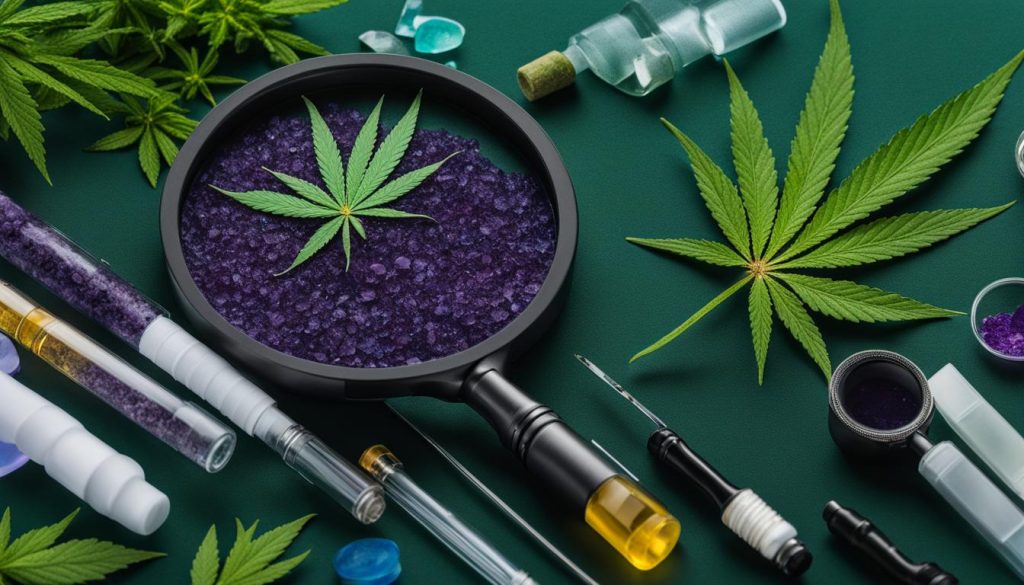
| Drug Testing Method | Detection Window | Advantages | Limitations |
|---|---|---|---|
| Urine Test | Several days to a few weeks | Affordable, reliable | Shorter detection window, potential for false negatives |
| Hair Test | Approximately 90 days | Longer detection window, can detect long-term use | Higher cost, requires specialized analysis |
| Saliva Test | Up to 72 hours | Non-invasive, reasonable alternative | Shorter detection window |
| Blood Test | 12-24 hours, up to 7 days for heavy or frequent use | Useful for investigations, accurate for recent use | Invasive, shorter detection window |
False Positives and False Negatives in Cannabis Drug Testing
When it comes to cannabis drug testing, false positives and false negatives can occur, leading to inaccurate results. It’s important to understand the factors that can contribute to these erroneous outcomes.
Hemp-Seed Bars and CBD Supplements
One common cause of false positives in cannabis drug tests is the consumption of certain products that contain hemp seeds or CBD supplements. Hemp-seed bars, for example, may contain trace amounts of THC, the psychoactive component of cannabis, which can trigger a positive result. Similarly, CBD supplements derived from hemp may contain small amounts of THC, leading to false positives.
Consuming hemp-seed bars or CBD supplements can potentially trigger a false positive result in cannabis drug testing.
It’s important to note that more detailed and expensive tests, such as gas chromatography-mass spectrometry (GCMS), can differentiate between THC and other substances, providing more accurate results. These tests are often used as a follow-up when a positive result is obtained from a standard urine drug test.
Self-Administered Zinc
There have been claims that self-administered zinc can produce false negative results in cannabis drug testing. However, studies have refuted this claim, suggesting that zinc does not interfere with the detection of THC metabolites in urine. Therefore, relying on self-administered zinc as a method to pass a drug test may not be effective.
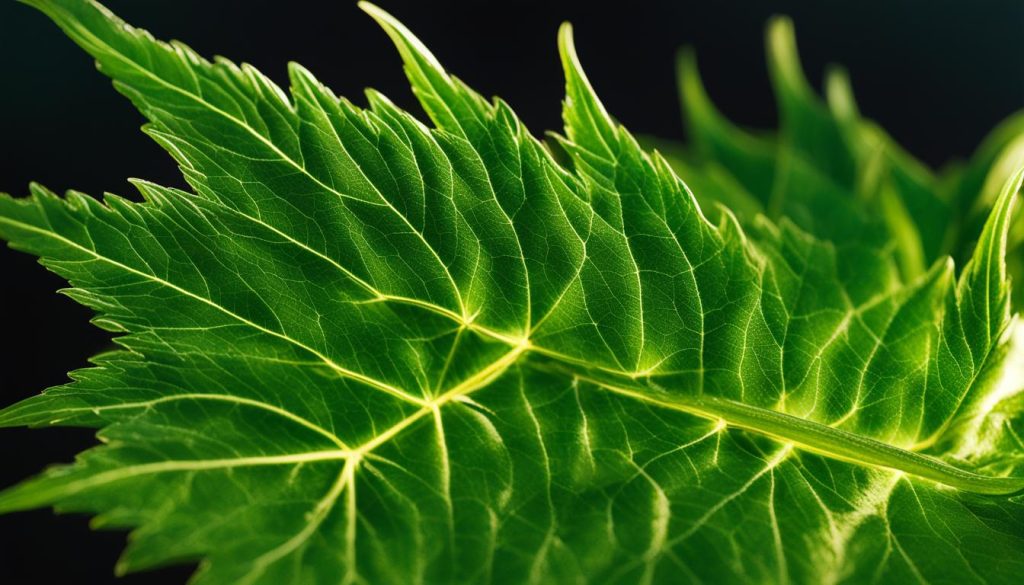
Table: Summary of False Positives and False Negatives in Cannabis Drug Testing
| False Positives | False Negatives |
|---|---|
| Hemp-seed bars | Self-administered zinc |
| CBD supplements |
Understanding the potential for false positives and false negatives in cannabis drug testing is crucial for accurately interpreting test results. It’s important to consider factors such as the consumption of hemp-seed bars and CBD supplements, as well as the limitations of different testing methods. By being aware of these factors, individuals can ensure that their drug test results are reliable and reflective of their true cannabis use.
Hair Testing for Cannabis
When it comes to detecting cannabis use, hair testing is a reliable method that analyzes the presence of THC-COOH in the hair shaft. This type of testing offers a longer detection window compared to other methods, typically spanning approximately 90 days. The length of the hair sample plays a role in determining the detection window, with body hair potentially providing a longer window due to its slower growth rate.
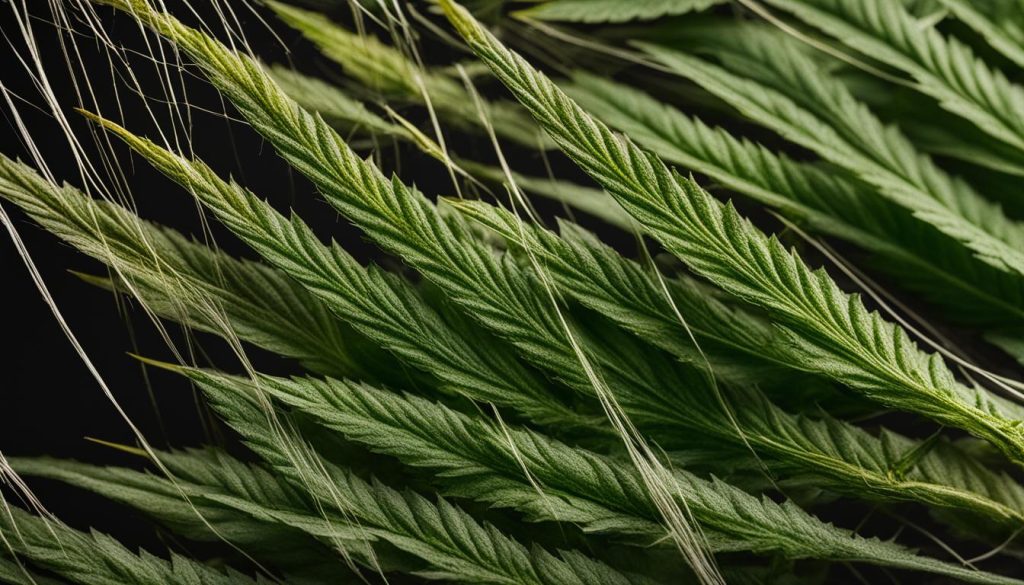
During hair testing, a small sample is collected close to the scalp and sent to a laboratory for analysis. The hair sample is washed to remove external contamination, and then the THC-COOH is extracted and analyzed using advanced techniques. This method is often used in pre-employment drug screening or forensic investigations due to its ability to provide a historical timeline of cannabis use.
It’s important to note that hair testing can only detect cannabis use that occurred during the time period in which the hair was growing. Therefore, it may not be as effective in detecting recent cannabis use. Additionally, it’s worth mentioning that hair testing does not differentiate between occasional or frequent use, as the presence of THC-COOH is not affected by usage frequency.
Advantages of Hair Testing for Cannabis:
- Long detection window of approximately 90 days
- Provides a historical timeline of cannabis use
- Difficult to adulterate or tamper with the results
Limitations of Hair Testing for Cannabis:
- Cannot detect recent cannabis use
- Does not differentiate between occasional or frequent use
- Requires a longer sample collection process compared to other testing methods
| Testing Method | Detection Window |
|---|---|
| Hair Testing | Approximately 90 days |
| Urine Testing | Up to 30 days |
| Saliva Testing | Up to 72 hours |
| Blood Testing | Approximately 12-24 hours |
Saliva Testing for Cannabis
Saliva testing is a reliable and convenient method to detect the presence of THC, the main psychoactive component of cannabis, in a person’s saliva. This type of drug test is often used for roadside testing and provides a reasonable alternative to other testing methods.
The detection window for THC in saliva is relatively short compared to other testing methods. THC is typically detectable in saliva for up to 72 hours after cannabis use. This means that saliva testing can effectively identify recent cannabis use within a few days.
Saliva testing offers several advantages. It is non-invasive and can be easily administered by collecting a saliva sample using a swab. The sample is then tested for the presence of THC using specialized devices. This makes saliva testing a convenient option for situations where immediate results are needed.
It is important to note that saliva testing has its limitations. While it can detect recent cannabis use, it may not be as effective in detecting cannabis use that occurred more than a few days ago. Additionally, factors such as the frequency and amount of cannabis use can affect the detection of THC in saliva.
Advantages of Saliva Testing for Cannabis:
- Reliable detection of recent cannabis use within a few days
- Non-invasive collection method using a saliva swab
- Convenient and quick results for immediate testing needs
Limitations of Saliva Testing for Cannabis:
- Short detection window compared to other testing methods
- May not effectively detect cannabis use that occurred more than a few days ago
- Factors such as frequency and amount of cannabis use can affect detection
In Conclusion
Saliva testing is a valuable tool for detecting recent cannabis use. It offers convenience, quick results, and reliable detection within a short detection window. However, it is important to consider its limitations and understand that it may not be suitable for detecting cannabis use that occurred more than a few days ago. By considering these factors, saliva testing can provide valuable insights in various testing scenarios.
Blood Testing for Cannabis
Blood testing is a less commonly used method for cannabis drug testing due to its invasive nature. It involves taking a blood sample and analyzing it for the presence of THC, the primary psychoactive compound in cannabis. Blood tests are often utilized in investigations of accidents, injuries, and impaired driving cases, where immediate detection of THC impairment is crucial.
When it comes to the detection window for THC in blood, it is relatively short compared to other testing methods. THC can typically be detected in the blood for approximately 12-24 hours after cannabis use. However, heavy or frequent cannabis use may result in THC being detectable for up to 7 days. It’s important to note that individual factors such as metabolism and dosage can also influence the detection window.
Blood testing offers a direct measure of recent cannabis use, as it detects the active THC compound in the bloodstream. However, it is important to interpret blood test results in conjunction with other factors to assess impairment accurately. It is also worth mentioning that blood testing is more expensive and time-consuming compared to other methods, which may limit its practicality in certain situations.
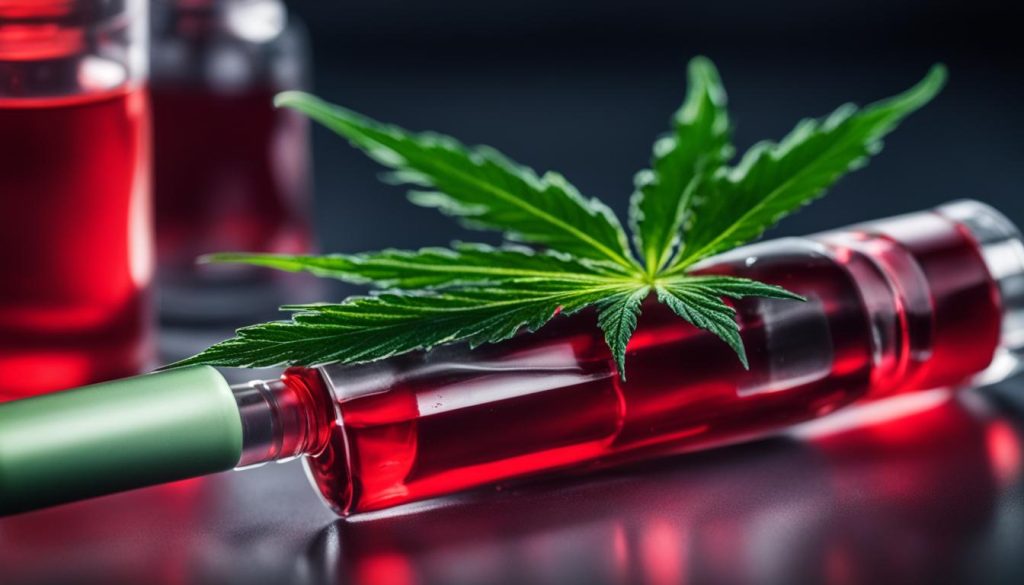
In conclusion, blood testing provides a method for detecting recent cannabis use and assessing impairment. Although it has a relatively short detection window, it can be valuable in specific circumstances such as accident investigations. It is crucial to consider individual factors and interpret blood test results in conjunction with other relevant information to accurately assess cannabis use and impairment.
Conclusion
In conclusion, our understanding of marijuana strains and THC in cannabis drug testing is crucial for accurate interpretation of test results. The detection window for THC varies depending on factors such as the frequency and amount of cannabis use, individual metabolism, and the type of drug test employed. It is important to consider these factors when analyzing test results to differentiate between recent cannabis use and residual drug excretion.
With the knowledge that THC is the main psychoactive component of cannabis and rapidly metabolized into THC-COOH, drug tests rely on the detection of THC-COOH to identify cannabis use. THC metabolism and clearance can be influenced by various factors, including drug dose, route of administration, metabolic rate, and individual differences.
Although false positives and false negatives can occur in cannabis drug testing, more detailed and expensive tests, such as gas chromatography-mass spectrometry (GCMS), can distinguish THC from other substances. While the belief in a 30-day detection window for THC is not supported by scientific research, it is important to note that extended detection times have been observed in heavy users.
Overall, a comprehensive understanding of the persistence of THC in drug tests is essential to ensure accurate interpretation of results. By considering the various factors involved in THC detection, we can effectively differentiate between new cannabis use and residual drug excretion in cannabis drug testing.
















